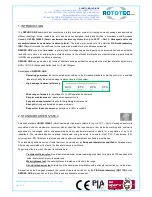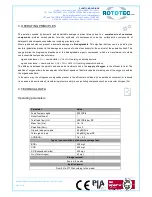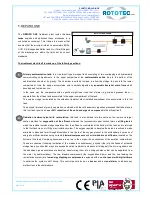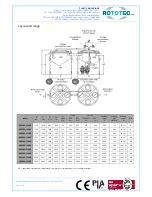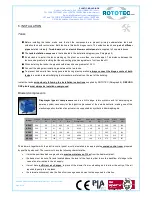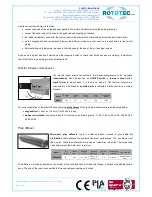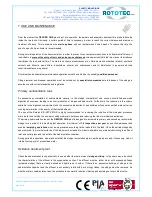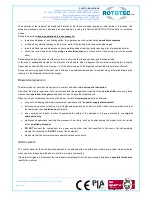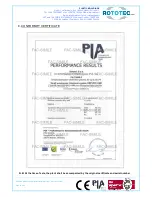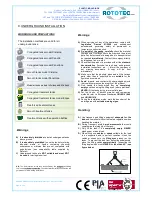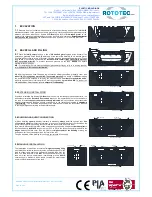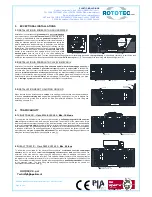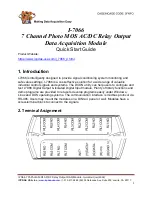
PLASTIC MOULDINGS
V
IA DELL
’
ARTIGIANATO
,
6
•
61026
LUNANO
(PU)
•
I
TALY
T
EL
.
+39
0722
722801
•
F
AX
+39
0722
70599
•
W
EB
:
www.rototec.it
E-
:
•
PEC
VAT
and TAX
CODE
01476690415
•
C
OMPANY
C
APITAL
.
120.000,00
CCIAA
(C
HAMBER OF
C
OMMERCE
R
EG
.
N.)
12602
P
ESARO
DEPURO ONE Use and Maintenance Manual, Rev. 00 of 27/01/2016
Page 3 of 13
3. OPERATING PRINCIPLES
The pollution caused by domestic and assimilable sewage is almost always due to a complex mix of numerous
compounds: proteins, carbohydrates, fats, the synthesis of substances such as the surface-active components of
detergents and nitrogenous substances, including principally urea.
Most organic substances present in domestic sewage are biodegradable. This signifies that they can be “used” by the
bacterial population present in the sewage as a source of nutrient necessary for the survival of the population itself. This
usage implies the progressive breakdown of the biodegradable organic compounds, which are transformed into stable
non-putrescible compounds as follows:
- organic sub O
2
→
new ba CO
2
+ H
2
O working as aerobic bacteria
- organic substance
→
new ba CO
2
+ CH
4
+ H
2
S+ H
2
O working anaerobic bacteria
The difference between the aerobic and anaerobic treatments lies in the supply of oxygen to the effluent to treat. The
addition of oxygen allows the development of different species of bacteria capable of making use of the oxygen to oxidise
the organic substrata.
In the same way, the nitrogenous compounds present in the effluent are oxidised (in an aerobic environment) or reduced
(in an anaerobic environment), transforming into more simple, non-polluting compounds such as molecular nitrogen (N
2
).
4. TECHNICAL DATA
Operating parameters
Parameter
Value
Feed flow per capita
200 l/PE/d
Runoff coefficient
1
Total feed flow (HL)
200 l/PE/d per PE
Mean flow (Q
24
)
HL: 16
Peak flow (Q
max
)
Q
24
x 3
Organic load per capita
60 gBOD
5
/d
Total organic load
60 gBOD
5
/d per PE
COD/BOD
5
1.6 – 2.2
Typical concentrations of domestic sewage feed
BOD
5
300 mg/l
COD
600 mg/l
SS (Suspended Solids)
400 mg/l
N
tot
(Total nitrogen)
40 mg/l
Sludge removal
Every 6-8 months
Installed power
From 92 to 277 W according to the model


